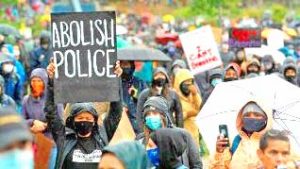High School Teacher Reflects on Capitol Hill Occupied Protest: Political Climate Calls Us to Build for Communist Revolution
SEATTLE (US)—After the death of George Floyd, thousands battled the police in the Capitol Hill neighborhood. Protestors came back every night to confront the cops at the local East Precinct. The police attacked the protestors repeatedly, unprovoked, with flash-bang grenades, pepper spray and CS gas.
After eight days of protests, the cops abandoned the precinct. The demonstrators immediately claimed seven square blocks around the precinct, including half of a large park. Protesters held the space as CHOP (Capitol Hill Occupied Protest) for more than two weeks.
Within a week, the city played on the divisions and lack of clear leadership to co-opt the occupation. They installed new barricades that make it difficult to protect CHOP from attack. In my opinion, the occupation gave up all its leverage at that point. The city is now reopening the East Precinct and reclaiming the streets in phases.
Early on, demands were agreed upon by enough people that they became the unofficial reason for the occupation. There were three: defund the Seattle Police Department by 50%; give that money to Black and brown communities; and freedom for all protesters.
CHOP became a magnet for armed fascists and right-wing groups. Small groups of Proud Boys, some armed, made appearances. In one armed attack a man drove his car into the protesters and shot someone in the arm. There have also been at least two other Proud Boys attacks on protesters and/or Black people around the outside of the space.
If we think of CHOP as an experiment in establishing a different kind of society, we can draw some important lessons.
First, people can quickly develop support systems to take care of each other. Participants developed systems for feeding, clothing and providing for people’s needs. Volunteer medic and mental health teams emerged. A crew self-organized for cleanup and trash removal. Community-generated funding maintained portable bathrooms.
Second, without mass commitment to basic communist principles, bureaucratic structures of power quickly reasserted themselves. Security teams started to act more like mini-police forces. General assemblies quickly devolved into clashes of egos and battles for the spotlight.
Third, being anti-racist, as important as that is, was not enough. There was a culture in the space to lift up and prioritize Black voices, especially Black women’s voices. But this was often done uncritically, and people ended up following leadership from Black men and women with reactionary politics.
Finally, the tension of the occupation and immediate threats made it difficult to broaden the focus of the discussions. Many participants wanted to imagine a different sort of society, but the immediate needs took precedence. Everyone in the space agreed that “Black Lives Matter” but that agreement quickly became superficial, even a cliché.

SEATTLE (US), June 12—Sixty thousand anti-racists marched two miles, many carrying signs saying “Defund the SPD” and “Abolish the Police.” Millions around the world are making similar demands. Only communism can put an end to racist killer cops by mobilizing masses.
Discussions about communism are critical, even when faced with threats. The Chinese Red Army had mass meetings on the battlefield. These meetings helped soldiers develop a clearer idea about the nature of the communist society they were fighting for. After winning the revolution, these rank-and-file troops went on to spark a decades-long battle within socialist China against revisionism and for communism.
CHOP was not sustainable, but its existence has added to a political climate in which the building of a revolutionary movement feels possible.
For future issues of Red Flag, comrades and friends will write more about how capitalism requires racist police forces and how communism will eliminate them.


